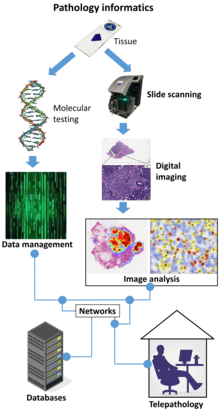
Telepathology is the practice of pathology at a distance. It uses telecommunications technology to facilitate the transfer of image-rich pathology data between distant locations for the purposes of diagnosis, education, and research.[1][2] Performance of telepathology requires that a pathologist selects the video images for analysis and the rendering of diagnoses.[3] The use of "television microscopy", the forerunner of telepathology, did not require that a pathologist have physical or virtual "hands-on" involvement in the selection of microscopic fields-of-view for analysis and diagnosis.
An academic pathologist, Ronald S. Weinstein, M.D., coined the term "telepathology" in 1986. In a medical journal editorial, Weinstein outlined the actions that would be needed to create remote pathology diagnostic services.[4] He and his collaborators published the first scientific paper on robotic telepathology.[5] Weinstein was also granted the first U.S. patents for robotic telepathology systems and telepathology diagnostic networks.[6] Weinstein is known to many as the "father of telepathology".[7] In Norway, Eide and Nordrum implemented the first sustainable clinical telepathology service in 1989;[8] this is still in operation decades later. A number of clinical telepathology services have benefited many thousands of patients in North America, Europe, and Asia.
Telepathology has been successfully used for many applications, including the rendering of histopathology tissue diagnoses at a distance. Although digital pathology imaging, including virtual microscopy, is the mode of choice for telepathology services in developed countries, analog telepathology imaging is still used for patient services in some developing countries.
- ^ Weinstein, RS; Graham, AM; Richter, LC; Barker, GP; Krupinski, EA; Lopez, AM; Yagi, Y; Gilbertson, JR; Bhattacharyya, AK; et al. (2009), "Overview of telepathology, virtual microscopy and whole slide imagining: Prospects for the future", Hum Pathol, 40 (8): 1057–1069, doi:10.1016/j.humpath.2009.04.006, PMID 19552937
- ^ Kumar S (2009), "Telepathology: An Audit", in Kumar S, Dunn BE (eds.), Tele-pathology, Springer-Verlag, pp. 225–229
- ^ Braunhut B, Graham A, Richter L, Webster P, Krupinski E (Sep 2013). "Fifth generation telepathology systems. Workflow analysis of the robotic dynamic telepathology Component". Diagnostic Pathology. 8 (1): S3. doi:10.1186/1746-1596-8-S1-S3. PMC 3849607.
- ^ Weinstein, RS (1986), "Prospects for telepathology (Editorial)", Hum Pathol, 17 (5): 433–434, doi:10.1016/s0046-8177(86)80028-4, PMID 3516858
- ^ Weinstein, RS; Bloom, KJ; Rozek, LS (1987), "Telepathology and the networking of pathology diagnostic services", Arch Pathol Lab Med, 111 (7): 646–652, PMID 3606341
- ^ Kayser, K; Szymas, J; Weinstein, RS (1999), Telepathology: Telecommunications, Electronic Education and Publication in Pathology, Springer, pp. 1–186
- ^ "ReUnion '10 award winners". Archived from the original on 2012-08-05.
- ^ Nordrum, I; Engum, B; Rinde, E; et al. (1991), "Remote frozen section service: A telepathology project to northern Norway.", Hum Pathol, 1991 (6): 514–518, doi:10.1016/0046-8177(91)90226-F, PMID 1864583